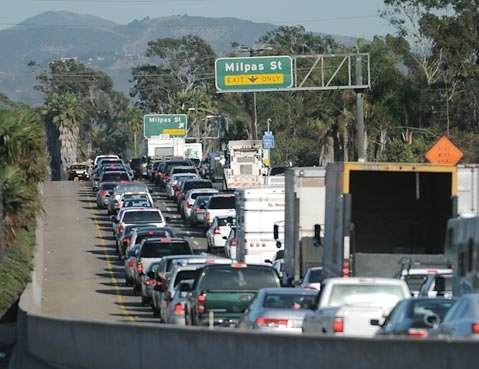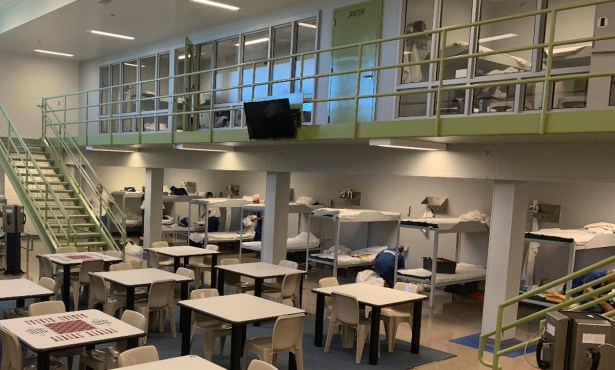Measure A Projects Must Wait
Highway 101 Widening Remains Priority; Goleta Wonders About Promised Overpass

Numerous projects promised as part of Measure A — the initiative approved by voters in November 2008 to raise money for transportation developments countywide — may not be built for more than 15 years, as the recession has reduced sales tax-based funding and slowed the additional financial support coming from the state and federal governments. According to projections, Santa Barbara County is expecting $40 million less funding than anticipated in the first five years of the program.
As such, a strategic plan presented to the Santa Barbara County Association of Governments (SBCAG) last Thursday recommends prioritizing the Highway 101 widening project ahead of all other proposals, effectively eating all regionally earmarked sales tax revenues as well as matching state and federal monies until the freeway’s five-stage, $420 million completion. The most visible project likely to be held up by this freeze is the new, $20 million-plus 101 overpass between the Storke and Winchester Canyon roads in Goleta, which is already in the community outreach phase but might not achieve the needed funding until 2026. Other projects also appear poised to wait in line, including the addition of passing lanes to Highway 246, work on Highway 166 east of Santa Maria, and the plans to renovate the Las Positas Road and 101 interchange, which was mandated by the City of Santa Barbara as a necessary part of the Cottage Hospital expansion plans.
“As the money becomes scarce, it seems like the only thing we can fund is the freeway,” said Goleta city councilmember Roger Aceves on Friday. “As a consequence, the $7 million that was going to be allocated to Goleta for the overpass won’t be available until 2027, which is not really acceptable.”
In hopes of expediting the overpass project, Aceves, City of Santa Barbara Mayor Helene Schneider, and other members of SBCAG — which oversees regional transportation projects as well as other county planning matters that cross jurisdictional boundaries — have asked that the board reconsider whether this prioritization is a proper policy and to determine with an up-or-down vote whether the overpass project should be allowed at least to proceed to “shovel-ready” status. SBCAG will vote on those issues at their April 15 meeting.
“There are a whole bunch of projects we’re going to deliver, but when voters approved Measure A, it didn’t identify schedules or matching funds,” explained SBCAG executive director Jim Kemp, who authored much of the strategic plan. “The strategic plan is what puts the meat on the bones for how we’re going to deliver it…. Highway 101 widening is the region’s highest priority project, so we incorporated that into the strategic plan and made it so it would be delivered as early as it can be.”
Kemp assured that SBCAG will be able to deliver all of the promised projects, but some may take the full 30 years of Measure A’s lifetime. “We’re going to deliver the projects,” said Kemp on Friday. “It’s really a question of how and when we deliver the projects.” The sales tax part of Measure A only provides for about one-third of the funds required, with the other two-thirds coming from matching funds. “The whole program is driven to a large extent by when these matching funds are available,” said Kemp. “We don’t get them all up front. They’re coming over the course of the next 30 years.”
So to plan properly, Kemp had to identify tradeoffs. “We can either do the 101 project as the priority or de-prioritize 101 to do other projects like the Goleta overpass,” said Kemp. “But we can’t do both. We have to make choices here.” Making those tough decisions will hopefully avoid a “free-for-all,” said Kemp, explaining, “We’re trying to develop a disciplined plan, not just firing off the starter’s gun and letting all projects go forward at the same time.” That could cause the 101 project to be delayed for “years and years and years,” said Kemp, while smaller projects consume the available money.
In the meantime, city leaders are scratching their heads in trying to determine what this means for other projects. Measure A, which replaces the similar transportation-funding Measure D starting on April 1, imposes a half-cent sales tax throughout the county for the next 30 years. The funds raised by the tax are to be split, with 78 percent going directly to cities to use as they see fit and 22 percent being spent on regional projects. The plan introduced last week deals strictly with that 22 percent, but also targets the additional funding expected from the state and feds.
While the 101 project is indeed regional in scope, many of the other projects falling under the “regional” banner — such as the Goleta overpass and the Las Positas re-do — are much more localized. However, because those projects require coordination with the state transportation agency Caltrans, they are deemed regional and are supposed to be processed through SBCAG (although, technically, the cities could also go straight to Caltrans). Specifically, SBCAG is no longer actively processing project study reports, or PSRs, which are the preliminary reports required by Caltrans to move forward with a project. With the PSRs for the overpass and Las Positas improvements in limbo, Aceves and Schneider believe their cities might miss out on possible state or federal funding, which tend to only go to “shovel-ready” projects with signed-off PSRs.
While the overpass will eventually be funded because it was listed specifically as a Measure A project, the City of Santa Barbara’s Las Positas project represents a different problem altogether, but one that’s perhaps more daunting to Santa Barbara County cities for the next 30 years. Because city decision-makers decided not to include the Las Positas project on the Measure A project list — which quickly grew to be quite long, expensive, and “controversial,” according to Schneider — they are now realizing that the regular state and federal funding streams may also be frozen by the Measure A plan. Basically, based on her reading of the strategic plan, Schneider thinks that projects otherwise unconnected to Measure A will also be stopped in their tracks until 101 is finished and other Measure A projects are funded.
“I’m not disputing the fact that we need to get [the 101] project accomplished,” explained Schneider, whose term with SBCAG started in January. “But my question at the meeting was: Is that project going to be the only regional project and then the others aren’t going to see the light of day for decades?…Had we known that, we would have at least put this particular project in the Measure A list of projects.” The city even made Cottage Hospital pay $250,000 for a transportation study. Schneider doubts that Santa Barbara is alone in such a conundrum. “I’m sure every city in every corner of the county has something that requires working with Caltrans,” said the mayor on Monday. “So what does that mean? Do we all go on hold for 30 years? That’s not what we bargained for.”
Schneider, like Aceves, is hoping that the Las Positas PSR can proceed in the event that state or federal monies — perhaps, she suggested, something earmarked for disaster preparedness, which the Cottage Hospital project could claim — become available. “We need to be shovel-ready,” said Schneider. “Where we are now, we’re not even at a point where we could start step one.” Aceves argued that Goleta and other cities need to be “thoughtfully positioned” in the event that, for instance, another federal jobs bill frees up money for the overpass project. “We’d have to take advantage of that,” said Aceves, explaining that often such funds must be spent within 90 days. “If we don’t, we lose, and the money will go elsewhere.”
So could there be a future opportunity in which state or federal funds go straight to the overpass while avoiding the prioritized 101 project? “It’s conceivable,” said SBCAG’s Kemp, “but I don’t think it’s likely.” But Kemp also said that SBCAG is not the real hold-up on these projects. “What Caltrans told us is they don’t have anybody on their staff currently to do the oversight,” he explained. “Right now, they don’t have the people to work on it even if we signed off on it.”
Both Aceves and Schneider recognize that Kemp is in a difficult position. “We’re caught in the middle between transitioning from Measure A to Measure D and the economic downturn and the lack of secure funding for major projects,” said Schneider. “He’s trying to do his best under bad circumstances.” However, both Aceves and Schneider also feel that the priorities, the way projects are funded, and the schedule for making these projects happen must be set by the SBCAG board and not by the staff. “The concern is who makes the policy,” said Schneider. “Is it the board or is it the staff?” Aceves agreed, and said that while he’s threatened to go straight to Caltrans, he prefers working via SBCAG. “We are a region. SBCAG is supposed to work together on this,” said Aceves. “But you can’t have a staff-driven policy. It’s got to be a board-driven policy. That’s the problem we have right now. The board needs to establish a policy.”
As well, Schneider and Aceves will be advocating for the strategic plan to be reexamined at regular intervals, perhaps between the five stages of the 101 project, in order for smaller projects to proceed. Kemp said that such reexamining is already expected. “We’ll be revisiting the strategic plan every couple years,” said Kemp. “Things could change. Projects could move up, or they could move back.”
Until then, Aceves, Schneider, and other politicians have to worry about whether their pledges will come back to bite them. “This is the promise we made to my constituents: They were going to get this bridge if they passed Measure A. We’re not the only ones that made promises,” said Aceves. “It’s a credibility issue: Are we coming through with what we promised?”



